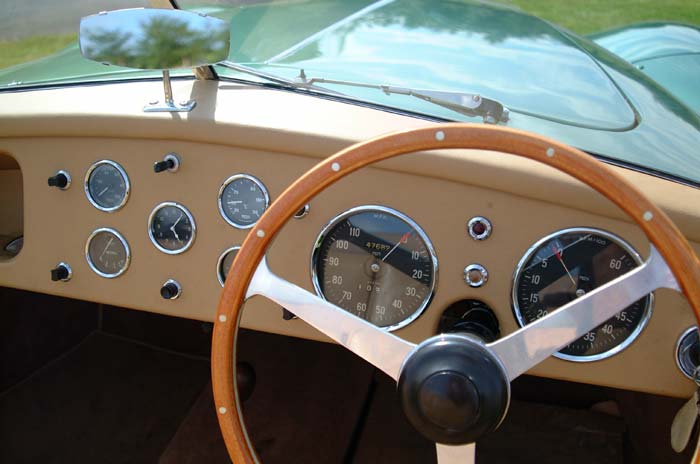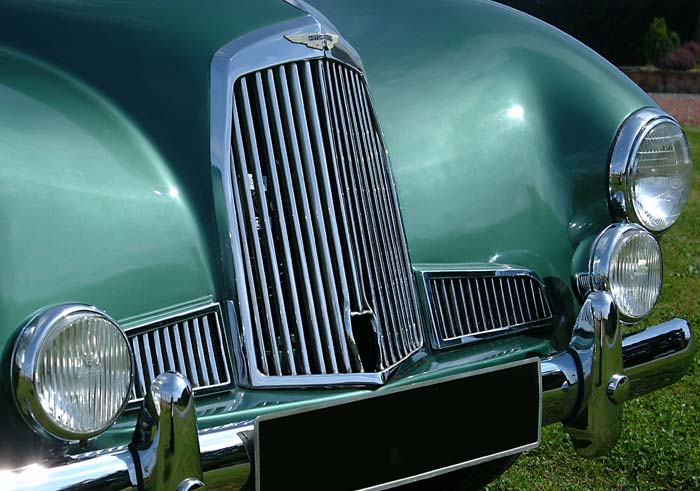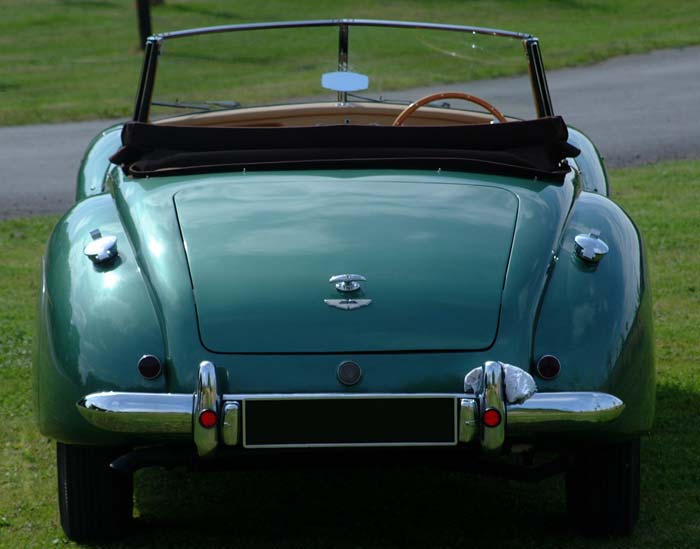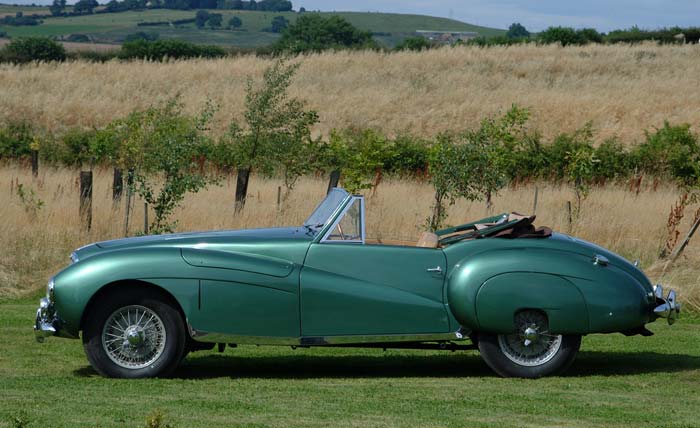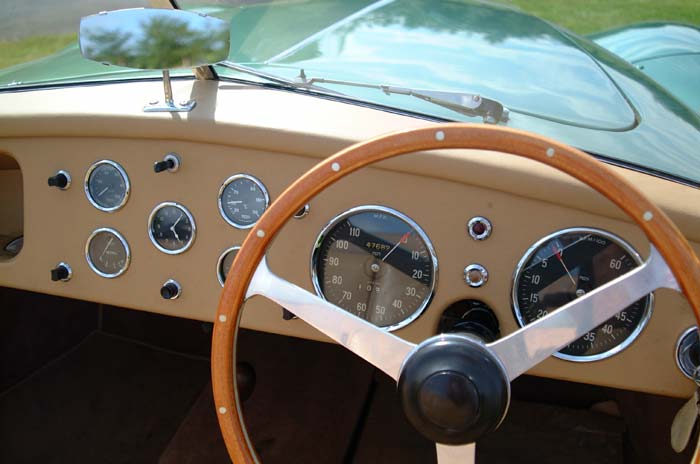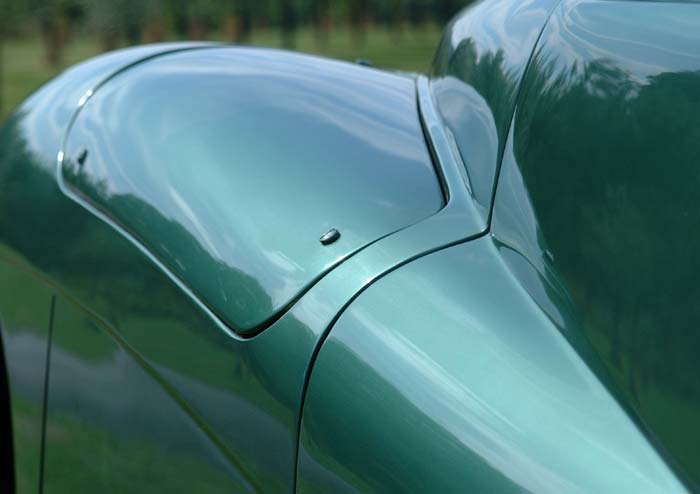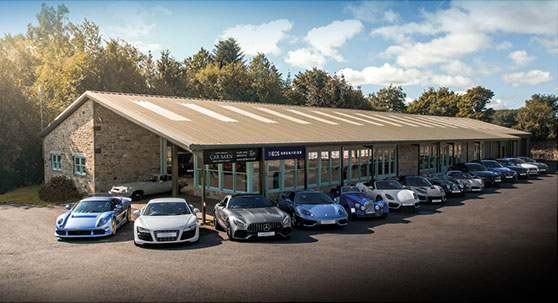DB1 - (2 Litre Sports) Restored
SOLDSpecification
Further Information
DB1 In production: September 1948 -May 1950 Chassis numbers: AMC/48/1 -AMC/50/15 {and Team Car LMA/48/1). One of only 13 roadsters produced, the car represents the first confident steps by Aston Martin after the end of the 2nd World War to get back into car production. Model History Gordon Sutherland and Claude Hill (Aston Martin Managing Director and Chief Engineer respectively) had finished building a completely new chassis and body early in 1939. Claude Hill had also been designing a new 2-litre engine. The chassis consisted of rectangular tubes, stiffened by square section bracing tubes, and the frame for the body panels was also formed by tubes, the whole providing a very stiff structure on which to suspend the wheels. Front suspension was independent for the first time on an Aston Martin, consisting of short trailing links and coil springs, but semi-elliptic leaf springs were retained for the rear axle. The layout of the divided track rod provided that the steering geometry is unaffected by cornering and bumps in the road. The wheelbase was 8' 6". Fitted initially with a standard pre-war 2-litre engine and a Cotal automatic gearbox {another sign of things to come), the car, which became known as the "Atom" saloon, {G40/900) was used during the war from 1942 by Gordon Sutherland. Two or three of Claude Hill's new four cylinder 2-litrc engines were completed by 1944, and one was fitted to the "Atom", although it was not announced until towards the end of 1946. The bore of 82 mm and stroke of 92 mm gave a capacity of 1,970 c.c., the compression ratio being a modest 7.25: and power output was given as 90 b.h.p. at 4, 750 r.p,m. The valves were operated by push rods, the unusual head having the inlet valves centred above the pistons and the exhaust valves at an angle in recesses leading to the manifold. Two SU carburettors were fitted. After the war, Claude Hill started to design a new car, but more capital was needed before a new model could be put into production. Aston Martin Ltd. was bought by David {later Sir David) Brown in February 1947, Sutherland and Hill remaining as directors. At about the same time the Lagonda company also joined the David Brown organisation. With financial support thus secured, design work proceeded, assisted by "Jock" St. John Horsfall. After extensive testing, including road work using an almost bare chassis {probably AMC/48/1), it was decided to give the chassis and engine the ultimate test by entering the 1948 Spa 24 hour Race. With little time available, a special body was built to complete the first post-war Aston Martin {LMA/48/1, the only Team DBI). Its brilliant outright win boded well for the new production car, which was announced at the London Motor Show later that year. It was described simply as a "Two Litre Sports", but became known as the DB1 when the DB2 was introduced. The rebuilt Spa car was also shown .on the stand shared by Aston Martin and Lagonda, but there was insufficient interest in the "Spa Replica" {at the price!) to warrant a production run. The tubular chassis and front suspension of the DBI are directly related to the chassis of the "Atom", with coil springs, short trailing arms and Armstrong shock absorbers, but with a strong torsion bar in an oil filled transverse tube. Rear suspension, however, is also by coil springs for the first time, the live axle being located transversely by a Panhard rod and fore and aft by parallel linkages. Transmission is through a Borg and Beck single plate clutch to a David Brown four-speed gear box and a hypoid bevel final drive. Overall ratios are 4,1, 5.17, 7.7 and 12:1 {for both first and reverse gears). Girling 12” drum brakes are fitted all round: tyres are 5.75" x 16". The DB1 body features the first fruits of the coming together of Lagonda’s styling provided by Frank Feeley and Aston Martin’s chassis and engine. However, David Brown very firmly indicated that he wished to see 6 cylinder engines in all future Aston Martins. As a result, no more that 13 examples of the DB1 were built and the DB2 was borne. Ownership First Registered 15th June 1950 to the Hon JCC Cavendish (later Lord Chesham) Initial Reg No OPD 53 The car was sold to HWM Motors in January 1957 1958 to 1960 P Palmer (Edgeware) 1968 to 1987 F Picknell 1987 to 1992 J.A. Tony Smith Acquired by Aston Workshop July 2005 The car comes with its original Registration documents Competition History 1951 Eight Clubs Silverstone (Cavendish) 3rd overall Restoration The car was subject to a major restoration The condition of the car, cosmetically and mechanically, is excellent and it is ready for immediate use. It has been registered as a car of Historic interest. This car is now SOLD
About Aston Workshop
Aston Workshop is an independent Aston Martin specialist located on Red Row Estate, an idyllic 37 acre venue set in the North East countryside. Red Row is located in County Durham, only 2 miles away from Beamish Museum, one of the North’s major tourist attractions. We offer a wide variety of contemporary Aston Martins for sale in our showroom including special editions, low mileage examples and high-performance models. Typically we have around 80 cars on-site at any given time. Additionally, we have an unrivalled selection of valuable heritage models which are rare and often rebuilt to bespoke specifications with discrete modern enhancements. Typically stocking fully restored examples, older restorations, drivers, 100% electric zero-emission EV conversions and even barn finds, our showroom is an unrivalled experience for the Aston Martin Enthusiast. We also build cars such as our DB4 GT Zagato recreations and our V8 Evolution 6.0.
Our sales showroom is supported by over 40 vastly experienced workshop staff working with a wide range of comprehensive in-house facilities including all aspects of Aston Martin diagnosis, repair, servicing and restoration to concours standards. Each member of our team works hard to ensure that we stay at the forefront of Aston engineering technology, Aston parts supply and full restorations including fixed-price services where applicable.
Our experienced team are also pleased to help and advise if you are a collector or seeking to purchase a car specifically for investment purposes.
The benefits of buying and selling with us include:
- Nationwide collection and delivery service on our own covered transporters
- Cars which are prepared by technicians working exclusively on Aston Martins
- Our own Aston Workshop Warranty
- A comprehensive customer service that truly works for the duration of ownership
- The confidence of dealing with a leading independent specialist established over 30 years
Sign up to our newsletter
Car Finder Service
Or why not try our Car Finder Service to locate your perfect match?
Sign up





